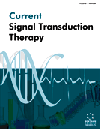- Home
- A-Z Publications
- Current Signal Transduction Therapy
- Previous Issues
- Volume 4, Issue 2, 2009
Current Signal Transduction Therapy - Volume 4, Issue 2, 2009
Volume 4, Issue 2, 2009
-
-
Mediators of Tyrosine Phosphorylation in Innate Immunity: From Host Defense to Inflammation onto Oncogenesis
More LessAuthors: Kamalika Nag and Anu ChaudharyCells respond to extracellular cues through a variety of receptors on the surface. These signals once transduced across the cell membrane, activate protein tyrosine kinases, which through phosphorylation of substrates on key tyrosine residues, are able to control cellular growth, activation and differentiation pathways. Recent data suggest that protein tyrosine kinases are critical in integrating signals from various Read More
-
-
-
Therapeutic Relevance of the Allosteric Modulation of the 5-HT Transporter
More LessAuthors: Ouissame Mnie-Filali, Mostafa E. Mansari, Connie Sanchez and Nasser HaddjeriThe serotonin (5-HT) transporter (SERT) is implicated in numerous neuropsychiatric disorders including major depression and represents the main target for antidepressants, especially for the selective serotonin reuptake inhibitors (SSRIs). A recently developed SSRI has the particularity to enhance its own reuptake inhibitory activity via the allosteric modulation of SERT. In this review, the SSRI escitalopram, the (S)-enantiom Read More
-
-
-
The Paradox of Oestradiol-Induced Breast Cancer Cell Growth and Apoptosis
More LessAuthors: Philipp Y. Maximov, Joan S. Lewis-Wambi and Virgil C. JordanHigh dose oestrogen therapy was used as a treatment for postmenopausal patients with breast cancer from the 1950s until the introduction of the safer antioestrogen, tamoxifen in the 1970s. The anti-tumour mechanism of high dose oestrogen therapy remained unknown. There was no enthusiasm to study these signal transduction pathways as oestrogen therapy has almost completely been eliminated from the treatme Read More
-
-
-
Inflammatory Signaling Networks as Targets for Pharmacological Intervention of Chronic Diseases
More LessAuthors: Urmila Maitra, Samantha M. Baglin and Liwu LiInflammatory signaling networks play critical roles in the interpretation and processing of external and internal challenges encountered by living organisms. Consequently, alterations in various inflammatory processes are linked with almost all human diseases, and provide important clues for potential pharmacological intervention. Macrophages and CD4 T helper cells are central modulators within the inflammatory network. B Read More
-
-
-
Estrogen Receptor Signaling: Impact on Cell Functions
More LessAuthors: Maria Marino and Filippo Acconcia17β-Estradiol (E2) controls many aspects of human physiology, including development, reproduction and homeostasis, through regulation of the transcriptional activity of its cognate receptors (ERs). E2 induces profound, rapid effects on the conformation of ERs allowing them to dimerize and to translocate into the nucleus where specific hormone response elements present in DNA are recognized. ER-E2 complex can also func Read More
-
-
-
The Role of Tregs in Cancer: Foxp3 as a Putative Target for Therapy
More LessAuthors: Brendan Meyer, Wai M. Liu, Angus G. Dalgleish and Christine GalustianThere is increasing evidence to support the idea that immune modulation is involved in cancer progression. Indeed, the growth in the number of publications describing cancer immunotherapy and how it impacts on cell signaling pathways reinforces this idea. In particular, the forkhead box P3 (Foxp3) transcription factor is an important protagonist in regulatory T cell (Treg) suppression, which has recently been reported to be m Read More
-
-
-
Signaling Intermediates (PI3K/PTEN/AKT/mTOR and RAF/MEK/ERK Pathways) as Therapeutic Targets for Anti-Cancer and Anti-Angiogenesis Treatments
More LessAuthors: Ludovica Ciuffreda, James A. McCubrey and Michele MilellaProtein phosphorylation catalyzed by protein kinases plays critical roles in the regulation of signal-transduction pathways. Deregulated kinase activity is observed in a variety of human diseases, such as cancer, making them targets for the development of molecular therapies. The PI3K/PTEN/AKT/mTOR and RAF/MEK/ERK signaling pathways play fundamental roles in transmitting signals from membrane receptors to Read More
-
-
-
Kupffer Cell-Dependent Signaling in Thyroid Hormone Calorigenesis: Possible Applications for Liver Preconditioning
More LessAuthors: Virginia Fernandez and Luis A. VidelaThyroid hormone (L-3,3,,5-triiodothyronine, T3) is important for the normal function of most tissues, with major actions on O2 consumption and metabolic rate. In the liver, these are due to (i) transcriptional activation of respiratory genes leading to increased reactive O2 species generation in mitochondria and other subcellular sites; and (ii) enhancement in the respiratory burst activity in Kupffer cells (KC), with consequent a Read More
-
Volumes & issues
-
Volume 20 (2025)
-
Volume 19 (2024)
-
Volume 18 (2023)
-
Volume 17 (2022)
-
Volume 16 (2021)
-
Volume 15 (2020)
-
Volume 14 (2019)
-
Volume 13 (2018)
-
Volume 12 (2017)
-
Volume 11 (2016)
-
Volume 10 (2015)
-
Volume 9 (2014)
-
Volume 8 (2013)
-
Volume 7 (2012)
-
Volume 6 (2011)
-
Volume 5 (2010)
-
Volume 4 (2009)
-
Volume 3 (2008)
-
Volume 2 (2007)
-
Volume 1 (2006)
Most Read This Month
Article
content/journals/cst
Journal
10
5
false
en


